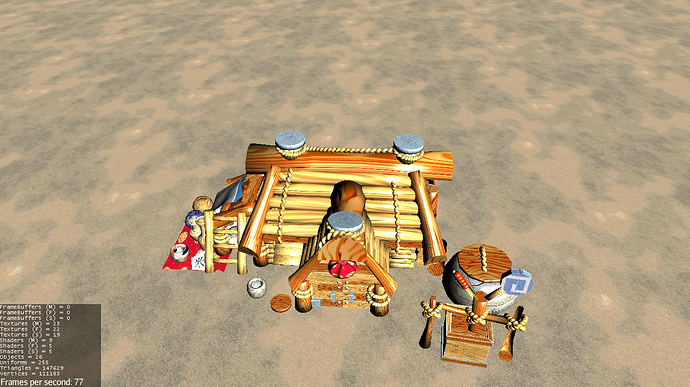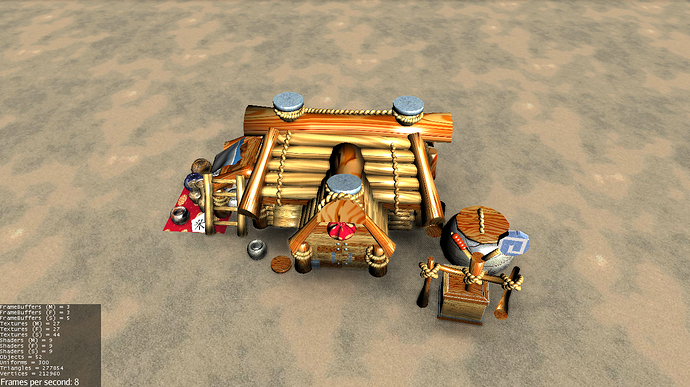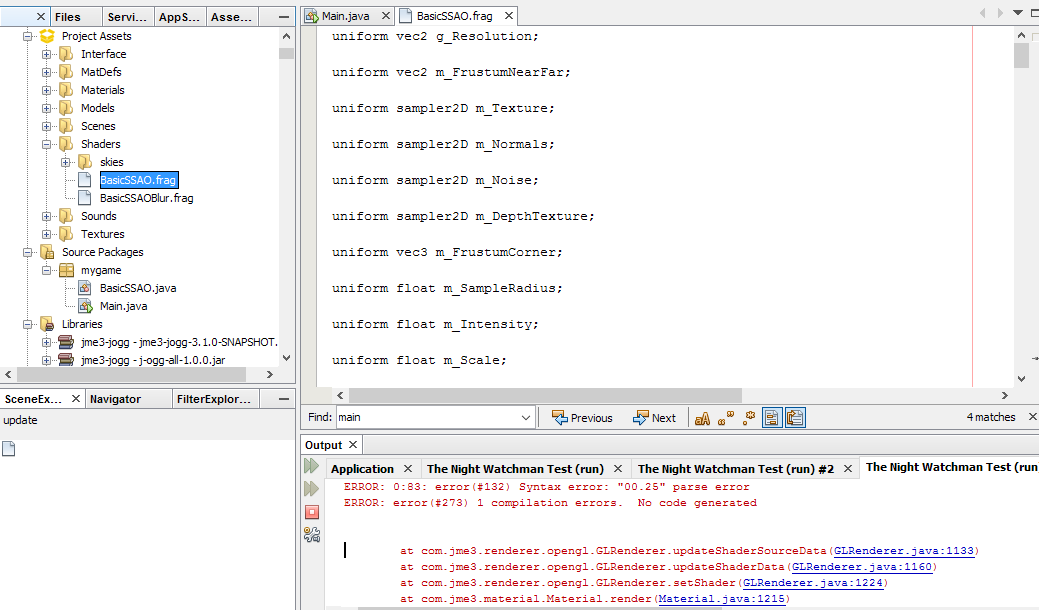Can you help with using this BasicSSAO ?
I know nothing about shader programming .
I created BassicSSAO.java class and copy and paste code from @t0neg0d .
then created two materials in MatDefs folder . BassicSSAO.j3md and BassicSSAOBlur.j3md and copy and paste code to them.
then created two shader in Shaders folder. BasicSSAO.frag and BasicSSAOBlur.frag and copy and paste code there.
and in my application :
FilterPostProcessor fpp= new FilterPostProcessor(assetManager);
viewPort.addProcessor(fpp);
BasicSSAO ssao = new BasicSSAO(3.0f, 10.5f, 0.5f, 0.025f);
ssao.setUseDetailPass(true);
ssao.setUseDistanceFalloff(true);
ssao.setFalloffStartDistance(250f);
ssao.setFalloffRate(4.0f);
fpp.addFilter(ssao);
and when running my game get this error :
Uncaught exception thrown in Thread[jME3 Main,5,main]
RendererException: compile error in: ShaderSource[name=Shaders/BasicSSAO.frag, defines, type=Fragment, language=GLSL100]
Fragment shader failed to compile with the following errors:
ERROR: 0:83: error(#132) Syntax error: "00.25" parse error
ERROR: error(#273) 1 compilation errors. No code generated
at com.jme3.renderer.opengl.GLRenderer.updateShaderSourceData(GLRenderer.java:1133)
at com.jme3.renderer.opengl.GLRenderer.updateShaderData(GLRenderer.java:1160)
at com.jme3.renderer.opengl.GLRenderer.setShader(GLRenderer.java:1224)
at com.jme3.material.Material.render(Material.java:1215)
at com.jme3.renderer.RenderManager.renderGeometry(RenderManager.java:564)
at com.jme3.post.FilterPostProcessor.renderProcessing(FilterPostProcessor.java:218)
at com.jme3.post.FilterPostProcessor.renderFilterChain(FilterPostProcessor.java:269)
at com.jme3.post.FilterPostProcessor.postFrame(FilterPostProcessor.java:320)
at com.jme3.renderer.RenderManager.renderViewPort(RenderManager.java:1045)
at com.jme3.renderer.RenderManager.render(RenderManager.java:1088)
at com.jme3.app.SimpleApplication.update(SimpleApplication.java:260)
at com.jme3.system.lwjgl.LwjglAbstractDisplay.runLoop(LwjglAbstractDisplay.java:151)
at com.jme3.system.lwjgl.LwjglDisplay.runLoop(LwjglDisplay.java:192)
at com.jme3.system.lwjgl.LwjglAbstractDisplay.run(LwjglAbstractDisplay.java:232)
at java.lang.Thread.run(Thread.java:745)
My BasicSSAO.frag file :
uniform vec2 g_Resolution;
uniform vec2 m_FrustumNearFar;
uniform sampler2D m_Texture;
uniform sampler2D m_Normals;
uniform sampler2D m_Noise;
uniform sampler2D m_DepthTexture;
uniform vec3 m_FrustumCorner;
uniform float m_SampleRadius;
uniform float m_Intensity;
uniform float m_Scale;
uniform float m_Bias;
uniform bool m_EnableFD;
uniform float m_SampleRadiusFD;
uniform float m_IntensityFD;
uniform float m_ScaleFD;
uniform float m_BiasFD;
uniform vec3[12] m_Samples;
uniform bool m_UseDistanceFalloff;
uniform float m_FalloffStartDistance;
uniform float m_FalloffRate;
varying vec2 texCoord;
float depthv;
float shadowFactor;
vec3 getPosition(in vec2 uv){
depthv = texture2D(m_DepthTexture,uv).r;
float depth= (2.0 * m_FrustumNearFar.x) / (m_FrustumNearFar.y + m_FrustumNearFar.x - depthv* (m_FrustumNearFar.y-m_FrustumNearFar.x));
float x = mix(-m_FrustumCorner.x, m_FrustumCorner.x, uv.x);
float y = mix(-m_FrustumCorner.y, m_FrustumCorner.y, uv.y);
return depth* vec3(x, y, m_FrustumCorner.z);
}
vec3 getNormal(in vec2 uv){
return normalize(texture2D(m_Normals, uv).xyz * 2.0 - 1.0);
}
vec3 getRandom(in vec2 uv){
float rand=(fract(uv.x*(g_Resolution.x/2.0))0.25)+(fract(uv.y(g_Resolution.y/2.0))*0.5);
return normalize(vec3(rand,rand,rand));
}
vec3 getNoise(in vec2 uv){
vec4 noise = texture2D(m_Noise, uv*25.0);
return (noise.xyz);
}
float doAmbientOcclusion(in vec2 tc, in vec3 pos, in vec3 norm){
vec3 diff = getPosition(tc)- pos;
vec3 v = normalize(diff);
float d = length(diff) * m_Scale;
return step(0.00002,d)*max(0.0, dot(norm, v) - m_Bias) * ( 1.0/(1.0 + d) ) * (m_Intensity+shadowFactor) * smoothstep(0.00002,0.0027,d);
}
float doAmbientOcclusionFD(in vec2 tc, in vec3 pos, in vec3 norm){
vec3 diff = getPosition(tc)- pos;
vec3 v = normalize(diff);
float d = length(diff) * m_ScaleFD;
return step(0.00002,d)*max(0.0, dot(norm, v) - m_BiasFD) * ( 1.0/(1.0 + d) ) * (m_IntensityFD+shadowFactor) * smoothstep(0.00002,0.0027,d);
}
vec3 reflection(in vec3 v1,in vec3 v2){
vec3 result= 2.0 * dot(v2, v1) * v2;
result=v1-result;
return result;
}
void main(){
float result;
vec3 position = getPosition(texCoord);
if(depthv==1.0){
gl_FragColor=vec4(1.0);
return;
}
vec3 normal = getNormal(texCoord);
vec3 rand = getRandom(texCoord);
float ao = 0.0;
shadowFactor = 0.075;//0.0;//(position.z*0.002);
float rad = m_SampleRadius/position.z+shadowFactor;
float radFD = m_SampleRadiusFD/position.z+shadowFactor;
int iterations = 12;
if (m_UseDistanceFalloff) {
float LOG2 = 1.442695;
vec2 m_DistanceFrustum = vec2(1.0,m_FalloffStartDistance);
float depth= (m_DistanceFrustum.x / 4.0) /
(m_DistanceFrustum.y - depthv *
(m_DistanceFrustum.y));
float falloffFactor = exp2( -m_FalloffRate * m_FalloffRate * depth * depth * LOG2 );
falloffFactor = clamp(falloffFactor, 0.0, 1.0);
if (falloffFactor < 1.0) {
for (int j = 0; j < iterations; ++j) {
vec3 coord1 = reflection(vec3(m_Samples[j]), rand) * vec3(rad);
ao += doAmbientOcclusion(texCoord + coord1.xy * 0.125, position, normal) - shadowFactor;
// Fine Detail
if (m_EnableFD) {
vec3 coord2 = reflection(vec3(m_Samples[j]), rand) * vec3(radFD*0.5);
ao += doAmbientOcclusionFD(texCoord + coord2.xy * 0.05, position, normal) * (0.25-shadowFactor);
}
}
ao /= float(iterations) * (2.35-shadowFactor);
result = 1.0-ao;
result = mix(result,1.0,1.0-falloffFactor);
} else {
result = 1.0;
}
} else {
for (int j = 0; j < iterations; ++j) {
vec3 coord1 = reflection(vec3(m_Samples[j]), rand) * vec3(rad);
ao += doAmbientOcclusion(texCoord + coord1.xy * 0.125, position, normal) - shadowFactor;
// Fine Detail
if (m_EnableFD) {
vec3 coord2 = reflection(vec3(m_Samples[j]), rand) * vec3(radFD*0.5);
ao += doAmbientOcclusionFD(texCoord + coord2.xy * 0.05, position, normal) * (0.25-shadowFactor);
}
}
ao /= float(iterations) * (2.35-shadowFactor);
result = 1.0-ao;
}
gl_FragColor = vec4(vec3(result),1.0);
}
@nehon and @t0neg0d this question looks at you . Can you please help me ?
Where shold i fix “00.25” syntax parse error ? it was not inside BasicSSAO.frag.




